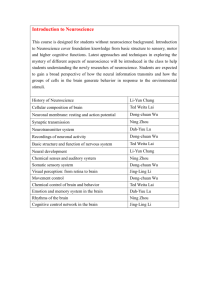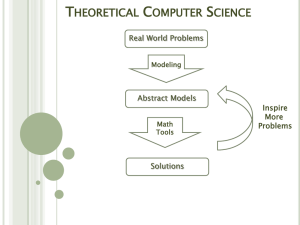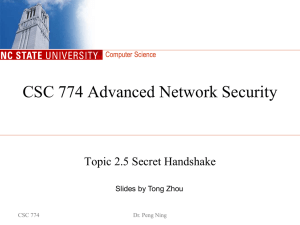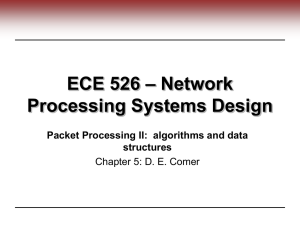Evaluation of the Use of the Online Community Tool Ning for
advertisement
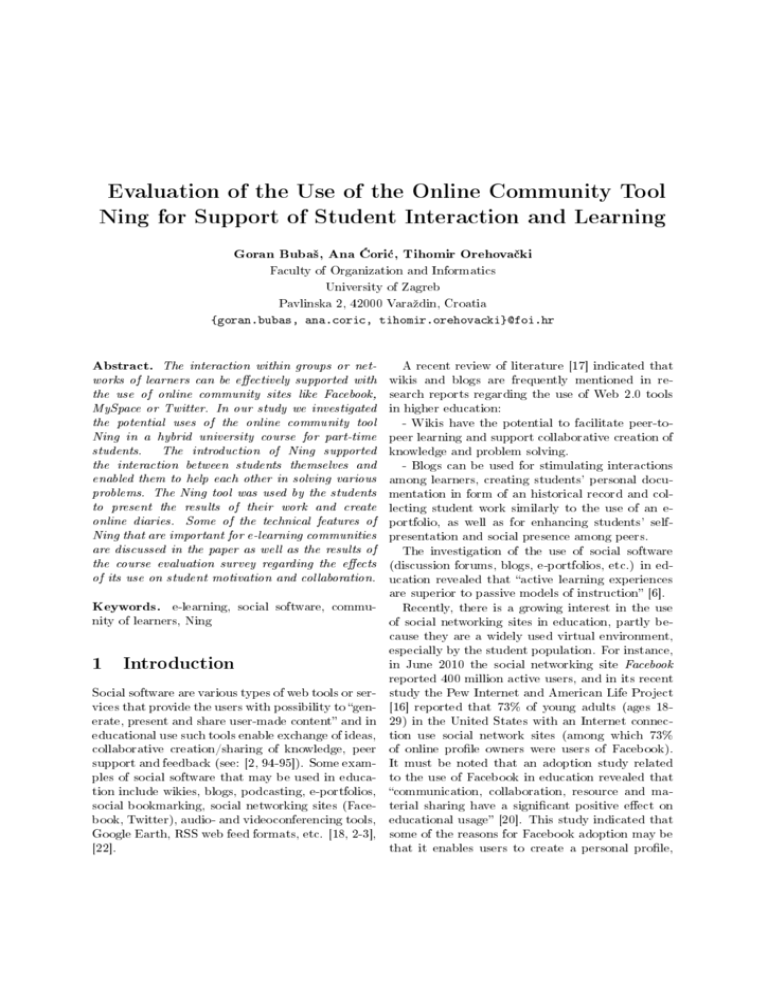
Evaluation of the Use of the Online Community Tool
Ning for Support of Student Interaction and Learning
Goran Buba², Ana ori¢, Tihomir Orehova£ki
Faculty of Organization and Informatics
University of Zagreb
Pavlinska 2, 42000 Varaºdin, Croatia
{goran.bubas, ana.coric, tihomir.orehovacki}@foi.hr
The interaction within groups or net-
A recent review of literature [17] indicated that
works of learners can be eectively supported with
wikis and blogs are frequently mentioned in re-
the use of online community sites like Facebook,
search reports regarding the use of Web 2.0 tools
MySpace or Twitter. In our study we investigated
in higher education:
Abstract.
the potential uses of the online community tool
- Wikis have the potential to facilitate peer-to-
Ning in a hybrid university course for part-time
peer learning and support collaborative creation of
students.
knowledge and problem solving.
The introduction of Ning supported
the interaction between students themselves and
- Blogs can be used for stimulating interactions
enabled them to help each other in solving various
among learners, creating students' personal docu-
problems. The Ning tool was used by the students
mentation in form of an historical record and col-
to present the results of their work and create
lecting student work similarly to the use of an e-
online diaries.
portfolio, as well as for enhancing students' self-
Some of the technical features of
Ning that are important for e-learning communities
presentation and social presence among peers.
are discussed in the paper as well as the results of
The investigation of the use of social software
the course evaluation survey regarding the eects
(discussion forums, blogs, e-portfolios, etc.) in ed-
of its use on student motivation and collaboration.
ucation revealed that active learning experiences
are superior to passive models of instruction [6].
Keywords.
e-learning, social software, commu-
nity of learners, Ning
Recently, there is a growing interest in the use
of social networking sites in education, partly because they are a widely used virtual environment,
1
Introduction
especially by the student population. For instance,
in June 2010 the social networking site Facebook
reported 400 million active users, and in its recent
Social software are various types of web tools or ser-
study the Pew Internet and American Life Project
vices that provide the users with possibility to gen-
[16] reported that 73% of young adults (ages 18-
erate, present and share user-made content and in
29) in the United States with an Internet connec-
educational use such tools enable exchange of ideas,
tion use social network sites (among which 73%
collaborative creation/sharing of knowledge, peer
of online prole owners were users of Facebook).
support and feedback (see: [2, 94-95]). Some exam-
It must be noted that an adoption study related
ples of social software that may be used in educa-
to the use of Facebook in education revealed that
tion include wikies, blogs, podcasting, e-portfolios,
communication, collaboration, resource and ma-
social bookmarking, social networking sites (Face-
terial sharing have a signicant positive eect on
book, Twitter), audio- and videoconferencing tools,
educational usage [20]. This study indicated that
Google Earth, RSS web feed formats, etc. [18, 2-3],
some of the reasons for Facebook adoption may be
[22].
that it enables users to create a personal prole,
communicate, share information, create photo al-
be applied to Web 2.0 applications, whose narrow
bums, chat and send messages, participate in group
specialization is in case of some of those web appli-
discussions, etc. Similar adoption related function-
cations suitable for conducting educational or busi-
alities are also oered by microblogging services like
ness related online activities. However, recent stud-
Twitter and online community sites like Elgg or
ies [8][25][28] have shown that previous approaches
Ning.
to evaluating usability are not appropriate for Web
The use of microblogging services has been con-
2.0 applications and therefore a set of attributes
sidered to have the potential to contribute to the
for assessing their overall quality was proposed [24].
e-learning and m-learning environment, predomi-
For instance, some of the potentially important us-
nantly because of the possibility to network and
ability attributes of Web 2.0 tools could be:
build community with other learners [5], as well as
•
because of their informal learning [4].
navigation techniques [13];
cial software and the so-called Pedagogy 2.0 approach in tertiary education which conrm that so-
•
cial networking sites like Facebook and Twitter can
Understandability, extent to which the capabilities of the web application are easy to com-
be eectively used to support e-learning, improve
prehend and unambiguous to the user [24];
interactivity and social presence of learners, as well
as facilitate collaborative knowledge discovery and
sharing [21].
Navigability, capability of web application to
provide the users with eective and alternative
There are numerous examples of the use of so-
•
Reliability, the capacity of web application to
There are also reports of the use of
maintain a stable and appropriate level of per-
online community sites like Elgg and Ning for ed-
formance under specic conditions for a spec-
ucation purpose [22].
ied period of time [13];
Such Web 2.0 tools can fa-
cilitate learner participation, creativity and online
•
identity formation creating a need for more research
Security, ability to prevent accidental or delib-
on students' use of those tools in formal and infor-
erate unauthorized access to les or personal
mal learning [7].
data [13];
However, social networking sites are not to be
•
considered as a replacement for Learning Manage-
meet user expectations [24].
ment Systems but as supplement tools for knowledge construction and sharing, collaboration and
dialogue with transparency and the ability to create awareness between students as some of their
most important characteristics [3].
Satisfaction, capability of web application to
2
Problem and hypotheses
The main problem of the study that is presented in
Usability is one of the key factors of software
this paper is to test the potential of the use of the
quality and is often mentioned as crucial for the
online community tool Ning to support pedagogy,
success of web applications [19][24]. It describes the
facilitate student interaction, and improve satisfac-
quality of web applications from the viewpoint of
tion and learning of students of the academic course
people who use them. There are many denitions of
entitled Computer-Mediated Communication.
usability, which dier according to the theoretical
models they are based on. However, usability is not
Four hypotheses have been formulated to investigate the problem of the study:
considered as an attribute itself but as a separate
H1. The use of the online community tool Ning
unit composed from several dierent attributes of
is perceived as useful in comparison to other Web
quality. Consequently, usability can be dened as
2.0 tools used in the academic course Computer-
an extent to which it is easy to nd and understand
mediated Communication and it contributes to the
information located on the website [15]; as the abil-
educational eects of this course.
ity to easily and eectively use the software product
H2. The use of the online community tool Ning is
[1]; and as an extent to which software allows users
perceived as interesting and motivating to the stu-
to achieve specic objectives with eciency, eec-
dents of the academic course Computer-Mediated
tiveness and satisfaction in a specied context of
Communication and it also contributes to the en-
use [11][12].
richment of educational experience of students.
All aforementioned denitions could
H3.
The use of the online community tool
part-time students who were between 19 and 35
Ning facilitates collaborative learning and peer in-
years of age.
teraction in study groups of the academic course
group were from 12 male and 11 female subjects
Computer-Mediated Communication.
(N=23), while the surveys collected in the second
The surveys collected in the rst
The technology of the Ning tool does not
group were from 10 male and 5 female subjects
manifest usability problems when it is used in con-
(N=15). For the purpose of this study the survey
crete educational settings of the academic course
data is supplemented with observation of student
Computer-Mediated Communication.
work and online discussions as a result of their use
H4.
of the Ning tool.
3
Method
The
online
4
community
tool
Ning
was
used
in
the academic year 2009/2010 in two study groups
of
part
time
students
of
the
academic
course
Computer-Mediated Communication at the Faculty of Organization and Informatics, University
of Zagreb, Croatia.
The students were asked to
use Ning to create their personal proles, upload
photos and links to video les on YouTube that
illustrate the content of the course, participate in
discussion forums on various course related topics,
keep an online diary of course related activities (lectures) in a blog, and present the artifacts that they
had created with Web 2.0 tools in their blog. The
students could also make friend lists and participate
in chat activities by using the Ning tool. For each of
the two study groups a separate virtual community
(ning network) was created.
At the end of the course, after the students
Results
The responses of the subjects to the survey items
Evaluation of usefulness of working with Ning system and Evaluation of usability of technology of
the Ning system in teaching (possible educational
eects) are presented in Figure 1. It must be noted
that the response scale was in the range from 1
- very poor to 5 - very good.
It can be con-
cluded from the data presented in Figure 1 that
Ning received rather high average evaluations regarding usefulness (M=4.66) and usability of technology in teaching (M=4.42). Also, Ning received
slightly better average evaluation than the mindmaping tool Bubbl.us or block-diagram tool Gliy.
Since the average responses for both study groups
were similar, the calculations presented in Figure 1
were performed on all subjects who participated in
our study.
passed the nal exam, they were asked to complete
a course evaluation survey. The survey consisted of
items related to the academic course ComputerMediated Communication in general, and also of
items related to specic educational eects of the
use of Ning and two other Web 2.0 tools (Bubbl.us
for the creation of mind-maps and Gliy for the
drawing of block-diagrams) that were used in this
course. This type of survey was regularly used for
course evaluation and for the purpose of this study
it was supplemented with several items for the evaluation of Ning tool regarding selected usability attributes. It must be emphasized that course evaluation surveys were collected only from the students
who have successfully passed the exam in 2-4 weeks
after the teaching was nished to ensure that they
Figure 1: The results of evaluation of usefulness of
could correctly remember and reproduce their ex-
the Ning tool and usability of Ning technology in
periences with course content and used Web 2.0
teaching (possible educational eects); N=38
tools.
The subjects in our study were two groups of
The typical open-ended responses of subjects to
this part of the course evaluation survey in rela-
MG2=4.48), and enrichment of educational expe-
tion to the usefulness and usability of technology
rience (MG1=4.27; MG2=4.74). In fact, many of
of Ning were: Great means for communication and
the students from both groups stated that the work
support, Very useful Ning network, The use of
with the Ning tool was one of the most interesting
Ning is useful because it enables easier learning of
activities of the course Computer-Mediated Com-
course content, I like the Ning system, etc. When
munication.
they were asked to state what they liked about the
dents commented that the use of Ning adds practi-
Ning system, some of the comments of the stu-
cal aspects to the course, makes it possible to create
dents were taking notes about lectures, exchange
a personal prole, includes diverse communication
of notes, maintaining a personal prole page and
channels for interaction, ensures more privacy than
forum, editing and publishing of my blog posts,
an open social network, etc. For instance, one stu-
writing blog posts, downloading photos, reading
dent stated that he was sure that, regarding the
the comments of other students, the possibility
use of Ning, for many students learning is easier
to get more information about the course, I liked
in that way because the course becomes more at-
just about everything.
tractive, and we must admit that is easier to learn
As a supplement to the course evaluation survey,
In their forum discussions the stu-
when it is fun and when we enjoy it.
the teachers of the academic course ComputerMediated Communication have asked the students
to participate in a forum discussion in Ning about
their experiences with this tool. The responses of
the participants in this online forum were mostly favorable. For instance, one participant stated that it
is a great way to connect students and professors,
accessible and simple, which is in correspondence
with the title of the course. However, many students indicated in their responses that there were
some usability and privacy related problems in the
use of Ning.
The data presented in Figure 1 and the openended responses of the subjects in our study conrm the rst hypothesis: H1. The use of the online
community tool Ning is perceived as useful in comparison to other Web 2.0 tools used in the academic
course Computer-mediated Communication and it
contributes to the educational eects of this course.
To evaluate the potential motivational eects of
the Ning tool the following items were included in
the course evaluation survey:
Figure 2: The results of evaluation of interesting-
ness of work with Ning tool, eect on increase
of motivation to learn, and enrichment of educa-
tional experience for Group 1 (N=15) and Group 2
(N=23)
Evaluation of in-
terestingness of work with Ning system, Increase
On the basis of the data presented in Figure 2 it
of my motivation for learning course content, and
can be concluded that the second hypothesis was
Enrichment of my `educational experience' during
also conrmed:
class attendance and while performing activities.
munity tool Ning is perceived as interesting and
The available responses were again in the range
motivating to the students of the academic course
from 1 - very poor to 5 - very good. The results
Computer-Mediated Communication and it also
for both groups of part time students are presented
contributes to the enrichment of educational experi-
in Figure 2.
As can be concluded from the data
ence of students. In fact, regarding interestingness,
presented in Figure 2, in both groups of subjects
motivation increase and enrichment of educational
the Ning tool was highly evaluated for interesting-
experience, the Ning tool was on the average more
ness (MG1=4.47; MG2=4.74), positive eects on
favorably rated than mind-mapping tool Bubbl.us
motivation for learning course content (MG1=4.33;
or block-diagram tool Gliy.
H2.
The use of the online com-
perience of group membership. The data presented
in Figure 3 enables the conrmation of the third
hypothesis:
H3.
The use of the online commu-
nity tool Ning facilitates collaborative learning and
peer interaction in study groups of the academic
course Computer-Mediated Communication .
In
fact in some of their comments the students compared Ning to Facebook, but also observed that it
is more suitable for groups of learners since it is
a closed network without unnecessary information
and distraction from other sources.
In their forum discussions many of the students
observed that they had technology related problems with Ning. For instance, they had problems
Figure 3: The results of evaluation of the contribu-
with the use of the chat tool, experienced data loss
tion of Ning tool to collaborative learning and pos-
when creating/editing blog posts and encountered
sibility for transfer of personal knowledge to other
unpredictable results of the use of the text editor of
students (N=38)
the blog tool, witnessed loss of user accounts, and
developed privacy concerns related to no logout status in situations after the browser application was
The evaluation of the potential for collaboration
closed and computer shut down.
and peer-to-peer learning with the Ning tool is pre-
To assess the usability of technology of the Ning
sented in Figure 3 as an average response to the
tool we have asked the students to evaluate some of
following survey questions:
the characteristics/attributes that were important
Collaborative learn-
ing (learning of new course related content on the
for its eective use in education.
basis of material created by other students) and
statistics are from 30 students who responded to
The possibility to provide others students with my
selected usability items that were used for course
knowledge, ideas and opinions.
evaluation with possible responses in the range
The rating was
performed on a scale in the range from 1 - very
poor to 5 - very good and both groups of sub-
The following
from 1 - totally disagree to 5 - totally agree.
The design of the user interface is an impor-
jects were included in data analysis. The results of
tant technological aspect of social software.
data analysis indicate that the Ning tool provides
case of the navigability
good possibility for collaborative learning and ex-
face 13% of the students who used Ning stated
change of information with other students.
that they disagree with the related statement It
In
attribute of user inter-
The interaction between participants in the Ning
is not possible to make a mistake when choosing
network is facilitated with the functionalities like
options/functionalities of web application for per-
blog, forum, chat, internal messages, and prole
forming dierent activities. Also, in relation to in-
pages. For the students of the course Computer-
tuitivity (i.e. understandability) of Ning user inter-
Mediated Communication it was not only possi-
face 47% of students agreed with the statement To
ble to present their work to other members of the
understand the meaning of specic icons and sym-
group and communicate through diverse channels,
bols which represent the functionalities of the web
but they were also able to get to know each other
interface, additional explanation is needed.
better because of information that was shared on
means that less computer/Internet literate students
personal prole pages and as well as a consequence
could experience problems when learning how to
of their self-disclosure in blog posts, chat and fo-
use Ning user interface and perform activities with
rum discussions. Even though for most part-time
this tool that are not adequately represented in
students who participated in this course this was
the user interface. However, many of the students
their second year of study, many of them stated
stated that Ning has similarity with Facebook and
that Ning enabled them to learn more about their
since most students are at least occasional Face-
colleagues and form with them a more cohesive ex-
book users this could help them in managing the
This
user interface of Ning.
types of Web 2.0 tools which manifest basic us-
The problem of data loss when using the text
ability problems or create privacy concerns should
editor of the blog in Ning was mentioned in fo-
be avoided. In the case of Ning the technical prob-
rum discussions by several students of the course
lems were more an occasional cause of frustration
Computer-Mediated Communication.
than a serious dysfunction.
This was
Having in mind the
reected in the results of evaluation of technology
previously presented data on the technological as-
used in the course since 20% of those who partic-
pects of the use of the Ning tool the fourth hypoth-
ipated in this part of the survey disagreed with
esis can not be conrmed: H4.
the statement Web application enables automatic
the Ning tool does not manifest usability problems
backup of changes/data of the document. The pre-
when it is used in concrete educational settings of
vention of data loss could be linked to usability
the academic course Computer-Mediated Commu-
attributes like error prevention and recoverability.
nication .
The technology of
Potential loss of user data is an important problem when social software is considered for use in
education. Educational technology should not create distraction from the subject of learning, disrupt
5
Conclusion
the learning process or negatively inuence student
The study that is presented in this paper is based
motivation. The problems with the blog and chat
on the the Web 2.0 social networking tool Ning
functionalities of Ning were probably the main rea-
which has attracted considerable attention of the
son why as many as 57% of the students agreed
e-learning community. It must be emphasized that
with the statement The use of some functional-
in 2008 Ning had 500.000 registered social networks
ities of the web application can cause frustration
[27] and today it hosts numerous communities of
of users.
One other cause for frustration could
scholars and professionals in the eld of education
be privacy and security concerns since 10% of the
and e-learning. Ning can eectively be used in hy-
students stated that they were not sure that their
brid academic courses [9] and in teacher education
personal data and les are protected from unautho-
[23]. The results of our case study are in correspon-
rized use.
dence with positive eects of using Ning that are
Our ndings regarding the potential problems in
reported in other studies [14], for instance a greater
the use of the Ning tool for education purpose con-
level of personalization, use of a digital portfo-
rm that student feedback in form of forum dis-
lio, facilitation of communication and collaboration
cussions, in combination with an analysis of their
among students, increase in information sharing,
responses to selected items of a course evaluation
informal peer-to-peer learning, and socialization.
survey, are useful means for identication of issues
In fact, Ning is considered as a useful tool for online
that should be resolved either through training of
teachers with features that extend the possibilities
online learners to eectively use a social network-
of traditional online communication tools in edu-
ing tool in a hybrid course or by contacting the
cation [26]. Based on our experience of the use of
developers / administrators of the tool to make
Ning in the Computer-Mediated Communication
necessary corrections. In fact, the teachers of the
hybrid course we can conclude that Ning is a useful
course Computer-Mediated Communication have
tool for small groups of 15-40 students and that it
contacted the developers of the Ning tool to bring
can help connect part-time students who have less
their attention to some usability problems and they
face-to-face interaction in the classroom. Because
tried to resolve them.
of its functionalities (forum, blog, chat, personal
In our study we have identied the potential pos-
proles, events management, uploading of images
itive eects of the use of the online community tool
and video) it was very suitable for this course which
Ning on the outcomes of a hybrid university course,
deals with online communication technology. How-
including increased motivation, peer-to-peer learn-
ever, it may not be as accepted by students who
ing and greater collaboration of students. However,
meet frequently face-to-face or equally suitable for
educators should be responsible for potentially neg-
courses of dierent content and structure.
ative eects of the use of technology in their courses
creation of a sense of community may not be pos-
and those social software applications and other
sible for large study groups.
Also,
The
limitation
of
our
research
is
associated
[6] Ellison, N. & Wu, Y.: Blogging in the Class-
with data collection from a small number of stu-
room:
dents in two study groups who participated in the
Attitudes and Impact on Comprehension, Jour-
course evaluation survey and also with the specic
nal of Educational Multimedia and Hypermedia,
ICT skills that they shared as a consequence of
AACE, Chesapeake, VA, 2008, vol. 17, no. 1, pp.
their study of informatics and their attendance of
99-122.
the course Computer-Mediated Communication.
Therefore, it is not possible to generalize the nding to other educational settings with students of
dierent level of computer/Internet literacy and to
courses of other topics. However, the other reports
on the use of Ning that can be found in literature
are in concordance with the results that are presented in this paper. Still, as our nding indicate,
the potentially negative aspects of the use of online community tool Ning should also be taken into
account (see: [10]) which have implication on student training to eectively use this tool and preserve their online privacy.
A Preliminary Exploration of Student
[7] Greenhow,
C.,
Robelia,
B.,
Hughes,
age: Web 2.0 and classroom research: What path
should we take now?, Educational Researcher,
2009, vol. 38, no. 4, pp. 246-259.
[8] Hart, J., Ridley, C., Taher, F., Sas, C. & Dix,
A.: Exploring the Facebook Experience: A New
Approach to Usability, Proceedings of the 5th
Nordic conference on Human-computer interaction: building bridges, ACM, 2008, October 2022, Lund, Sweden, pp. 471-474.
[9] Holcomb, L., Brady, K. & Smith, B.:
References
Using
social networking tools in educational settings:
Student attitudes and perceptions of NING, In
[1] Bevan, N.: Quality in use: meeting user needs
for quality, Journal of Systems and Software,
1999, Vol. 49, No. 1, pp. 89-96.
[2] Brenton, S.:
J.E.:
Learning, teaching, and scholarship in a digital
I. Gibson et al. (Eds.), Proceedings of Society
for Information Technology & Teacher Education
International Conference, 2009, AACE, Chesapeake, VA, pp. 2551-2553.
E-learning - an introduction, In
H. Fry, S. Ketteridge and S. Marshall (eds.), A
Handbook for Teaching and Learning in Higher
Education: Enhancing Academic Practice, Routledge, New York, NY, pp. 85-98, 2009.
[10] Holcomb, L., Brady, K. & Smith, B.:
Ning
in Education: Can non-commercial, educationbased social networking sites really address the
privacy and safety concerns of educators?, In D.
Gibson & B. Dodge (Eds.), Proceedings of So-
[3] Dalsgaard, C.: Social networking sites: Trans-
ciety for Information Technology & Teacher Ed-
parency in online education, "VISION IT - Vi-
ucation International Conference, 2010, AACE,
sions for use of IT in higher education", 14th
Chesapeake, VA, pp. 528-531.
congress of the European University Information
Systems Organisation, EUNIS 2008, 24-27 June,
[11] Hornbaek, K.: Current practice in measuring
Aarhus, Denmark, 2008, Retrieved 31 May 2010,
usability: challenges to studies and research, In-
http://eunis.dk/papers/p41.pdf
ternational Journal of Human-Computer Studies, 2006, Vol. 64, No. 2, pp. 79-102.
[4] Ebner, M., Lienhardt, C., Rohsc, M., Meyerd,
I.: Microblogs in Higher Education - A chance
[12] ISO/IEC 9241-11: 1998 - Ergonomic require-
to facilitate informal and process-oriented learn-
ments for oce work with visual display termi-
ing?, Computers & Education, 2010, vol. 55, no.
nals (VDTs) - Part 11:
1, pp. 92-100.
1998, International Organization for Standard-
[5] Ebner,
M.,
Schiefner,
more than fun?
M.:
Microblogging -
Guidance on usability,
ization, Geneva.
Procceding of IADIS Mobile
[13] ISO/IEC 9126-1: 2001 - Software engineering
Learning Conference 2008, Inmaculada Arnedillo
- Product quality - Part 1: Quality model, 2001,
Sýnchez and Pedro IsaÃas ed., Algarve, Portu-
International Organization for Standardization,
gal, 2008, pp. 155-159.
Geneva.
[14] Karabulut, A., Braet, D., Lindstrom, D. &
Retrieved 31 May 2010, http://oro.open.ac.uk/
Niederhauser, D.: Student Level of Commitment
16141/3/Eective-use-of-Social-Software-in-
and Engagement with Ning as a Learning Man-
Education-CaseStudies.pdf
agement System, In I. Gibson et al. (Eds.), Proceedings of Society for Information Technology
& Teacher Education International Conference,
2009, AACE, Chesapeake, VA, pp. 2564-2569.
[15] Keevil,
B.:
Measuring the Usability Index
of Your Web Site, 1998, Keevil & Associates,
Toronto, Ontario, Canada.
[16] Lenhart,
Zickuhr,
net
Use
[Online
report],
Life
K.,
Media
Smith,
&
Teens
and
2010,
Pew
Project,
cation, In D. Gibson & B. Dodge (Eds.), Proceedings of Society for Information Technology
& Teacher Education International Conference,
2010, AACE, Chesapeake, VA, pp. 1802-1805.
[24] Orehova£ki, T.:
Proposal for a Set of Qual-
ity Attributes Relevant for Web 2.0 Applica-
Purcell,
Social
Among
American
2010,
A.,
K.:
[23] Olcese, N.: Ning as a Tool for Teacher Edu-
A.,
tion Success, Proceedings of the 32nd Interna-
Inter-
tional Conference on Information Technology In-
Adults
terfaces, IEEE, 2010, June 21-24, Cavtat, Croa-
Mobile
Young
Internet
Retrieved
http://www.pewinternet.org/
and
31
May
/
me-
tia, pp. 319-326.
[25] Silva, P.A. & Dix, A.: Usability - Not as we
dia//Files/Reports/2010/PIP_Social_Media_
know it!
and_Young_Adults_Report.pdf
Group Annual Conference on HCI 2007: People
Proceedings of the 21st British HCI
and Computers XXI: HCI...but not as we know
[17] Liu, M., Kalk, D., Kinney, L., Orr, G. & Reid,
M.: Web 2.0 and Its Use in Higher Education:
it - Volume 2, ACM, 2007, September 3-7, University of Lancaster, UK, pp. 103-106.
A Review of Literature, In T. Bastiaens et al.
(Eds.), Proceedings of World Conference on E-
[26] Smith, B. & Holcomb, L.: The Walled Gar-
Learning in Corporate, Government, Healthcare,
den approach to Social Networking:
and Higher Education 2009, AACE, Chesapeake,
Ning in distance education, In I. Gibson et al.
Utilizing
VA, pp. 2871-2880.
(Eds.), Proceedings of Society for Information
Technology & Teacher Education International
[18] Mason, R., Rennie, F.:
e-Learning and So-
cial Networking Handbook: Resources for Higher
Conference, 2009, AACE, Chesapeake, VA, pp.
2970-2973.
Education, Routledge, New York, NY, 2008.
[27] The
[19] Matera, M., Rizzo, F. & Toetti Carughi, G.:
on
Ning
Ning,
Blog,
2008,
500,000
Retrieved
social
31
networks
May
2010,
Web Usability: Principles and Evaluation Meth-
http://blog.ning.com/2008/10/500000-social-
ods, In Mendes, E. & Mosley, N. (Eds.), Web
networks-on-ning.html
Engineering, 2006, Springer Berlin Heidelberg,
[28] Thompson, A-J. & Kemp, E.A.: Web 2.0: ex-
pp. 143-180.
tending the framework for heuristic evaluation,
[20] Mazman, S.G., Usluel, Y.K.: Modeling educa-
Proceedings of the 10th International Conference
tional usage of Facebook, Computers & Educa-
NZ Chapter of the ACM's Special Interest Group
tion, 2010, vol. 55, no. 2, 444-453.
on Human-Computer Interaction, ACM, 2009,
[21] McLoughlin, C., Lee, M.J.W.: Social software
and participatory learning: Pedagogical choices
with technology aordances in the Web 2.0 era,
In ICT: Providing choices for learners and learning, Proceedings ascilite Singapore, 2007, pp.
664-675.
[22] Minocha, S.:
A study of the eective use of
social software to support student learning and
engagement. JISC, 2009, University of Bristol.
July 6-7, Auckland, New Zealand, pp. 29-36


